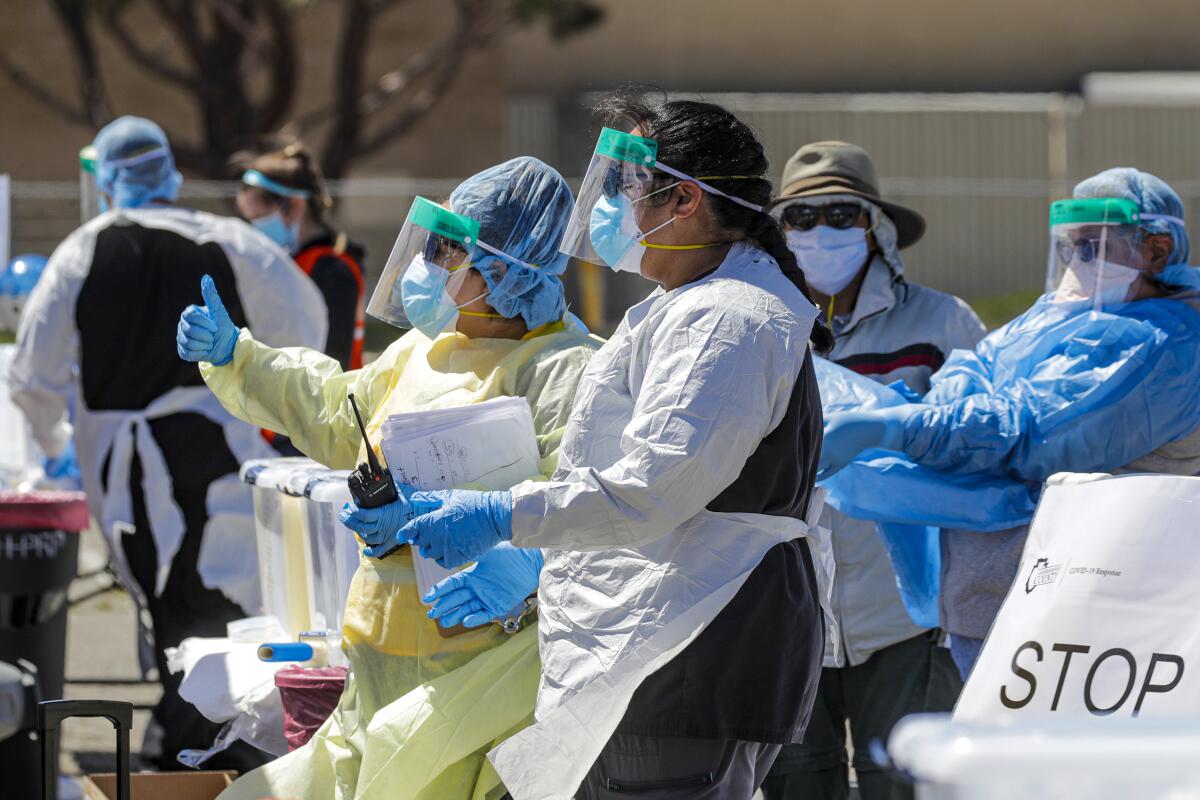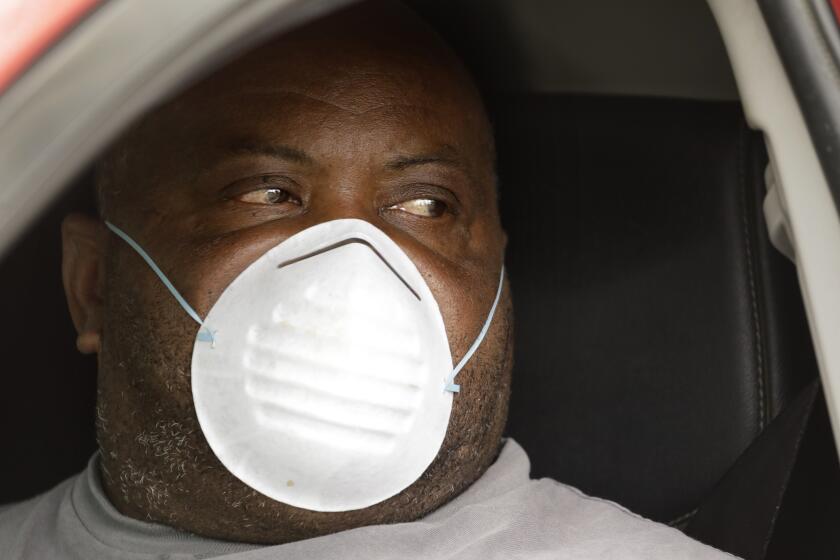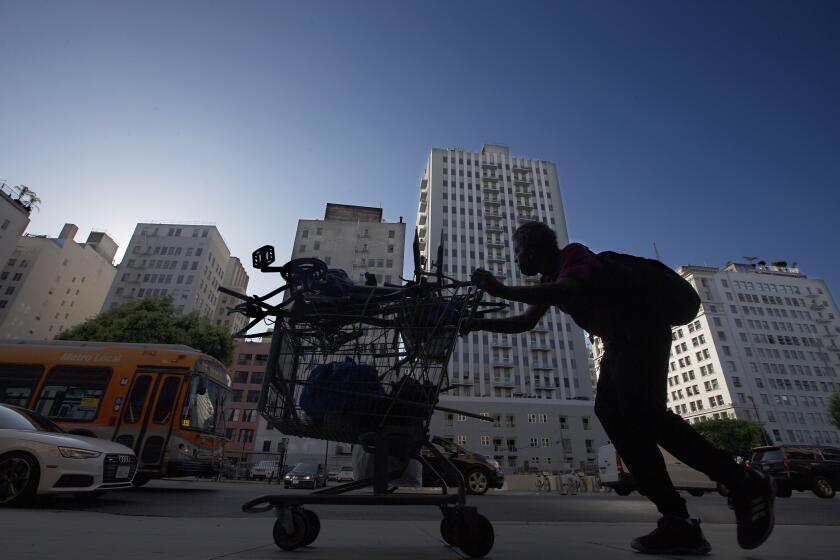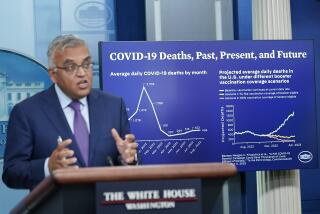At the RNC, the claims about COVID-19 pandemic do not match reality

- Share via
The pandemic is far from over.
Contrary to the impression left by many speakers at the Republican National Convention, it is still raging in the United States, with more than 40,000 new coronavirus infections and nearly 1,000 deaths per day. The U.S. death toll surpassed 180,000 on Thursday, higher than any other nation’s.
For months, America’s efforts at controlling the spread of the coronavirus have lagged behind those of all other major wealthy developed countries, including Canada, Japan, South Korea, Australia, Germany, France, Britain, Italy and Spain.
The United States makes up 4% of the world’s population, but 22% of its COVID-19 fatalities.
Yet at the Republican convention, speakers have avoided, minimized or distorted the pandemic’s epic and ongoing disruption of Americans’ lives. Larry Kudlow, director of the National Economic Council, talked about it Tuesday as if it were gone.
“It was awful,” he said. “Health and economic impacts were tragic. Hardship and heartbreak were everywhere.”
Ignoring President Trump’s weeks of early assurances that the virus was under control and would disappear on its own when in fact it was quietly spreading to millions of Americans, Kudlow went on: “But presidential leadership came swiftly and effectively with an extraordinary rescue for health and safety to successfully fight the COVID virus.”
On Wednesday, Vice President Mike Pence mocked Trump’s Democratic challenger, Joe Biden, for saying last week that “no miracle is coming.” “What Joe doesn’t seem to understand is that America is a nation of miracles,” Pence said shortly before joining Trump in personally greeting a front row of audience members standing shoulder-to-shoulder without masks.
Trump and Biden diverge on the coronavirus pandemic, Obamacare, Medicare and Medicaid, abortion rights, and how to rein in prescription drug prices.
In his White House convention speech Thursday night, Trump skipped the raw numbers of sick and dead Americans, saying critics were overlooking his administration’s “largest national mobilization since World War II” for effective treatments and a vaccine.
“Unfortunately, from the beginning, our opponents have shown themselves capable of nothing but a partisan ability to criticize,” he said.
Republicans’ dismissal of the steady rise in illness and death comes as Biden is putting the pandemic at the center of his campaign to unseat Trump. On Thursday, California Sen. Kamala Harris, Biden’s running mate, accused the president of incompetence and “reckless disregard” for Americans’ lives.
“The tragedy in all of this is that it didn’t have to be this bad,” she said. “Just look around. It’s not like this in the rest of the world.”
More than 38,000 Americans are hospitalized with COVID-19 this week — the same level as in early April when the pandemic was first spiraling out of control in New York City, Detroit, New Orleans and other cities.
Some countries that recovered from devastating outbreaks early in the pandemic — most notably Spain — have struggled to keep the virus from returning in force.
But none of the world’s biggest wealthy nations have matched the sustained failure of the United States to contain the virus, health data show.
For 10 years, downtown L.A. was booming with a youthful, renegade vibe. The coronavirus puts those hard-won gains at risk.
Neha Nanda, an epidemiologist at USC’s Keck School of Medicine, said one of the main reasons is America’s wide disparities in state-by-state approaches to requiring masks and enforcing social distancing by closing bars, restaurants and other venues where the virus can easily spread.
“It was totally disjointed,” she said.
Nationwide measures could have produced the kind of success that New York and other parts of the Northeast have had in recovering from early outbreaks that killed tens of thousands, she said. Instead, Arizona, Texas, Florida and other states took a more lax approach, only to be hammered this summer with deadly outbreaks that forced governors to roll back their reopenings.
“It’s like a shoal of fish,” Nanda said. “That predator is going to eat you up if you don’t swim together.”
The states with the most cases per 1 million people are now Mississippi, Alabama, Kansas and South Dakota, according to the Covid Tracking Project, an independent pandemic data source.
More to Read
Get the L.A. Times Politics newsletter
Deeply reported insights into legislation, politics and policy from Sacramento, Washington and beyond. In your inbox three times per week.
You may occasionally receive promotional content from the Los Angeles Times.













